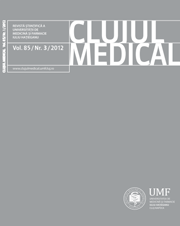Significance of C3d in the Assessment of the Renal Graft Biopsy in the Initial Post Transplant Period
Keywords:
renal graft biopsy, acute humoral rejection, acute tubular necrosis, C4d, C3dAbstract
Introduction. Demonstration of C4d deposition in peritubular capillaries is not synonymous with acute humoral rejection. Evaluation of C3d was credited to bring relevant prognostic information.
Objective. To analyze the C3d and C4d expression in renal biopsy for graft dysfunction and correlation with antibody mediated rejection.
Materials and methods. We evaluated 74 renal graft biopsies in the period: January 2006-December 2012. Biopsies of patients with acute humoral rejection (Gr. A.) and those with acute tubular necrosis (Gr. B.) were compared in terms of expression of C4d and C3d.
Results. Endothelial deposition of C3d was in highly significant statistic correlation (p=0.0001) with C4d deposition. The C3d test for humoral acute rejection has 89.47% sensitivity and 69.09% specificity. C3d correlated with the presence of polymorphonuclear neutrophils and thrombosis in the peritubular capillaries. Epithelial C3d correlated with the presence of acute tubular necrosis.
Conclusion. Immunohistochemical assessment of C3d in renal biopsy is an important ancillary test in the panel used to assess transplant renal biopsy. C3d deposition in peritubular capillaries correlates with the presence of acute humoral rejection while expression in the tubular epithelium correlates with the tubular ischemic lesions.
Downloads
Published
How to Cite
Issue
Section
License
The authors are required to transfer the copyright of the published paper to the journal. This is done by agreeing to sign the Copyright Assignment Form. Whenever the case, authors are also required to send permissions to reproduce material (such as illustrations) from the copyright holder.

The papers published in the journal are licensed under a Creative Commons Attribution-NonCommercial-NoDerivatives 4.0 International License.

